
Armillaria is a genus of fungi that includes the A. mellea species known as honey fungi that live on trees and woody shrubs. It includes about 10 species formerly categorized summarily as A. mellea. Armillarias are long-lived and form the largest living fungi in the world. The largest known organism covers more than 3.4 square miles (8.8 km2) in Oregon's Malheur National Forest and is estimated to be 2,500 years old. Some species of Armillaria display bioluminescence, resulting in foxfire.

Lactarius deterrimus, also known as false saffron milkcap or orange milkcap, is a species of fungus in the family Russulaceae. The fungus produces medium-sized fruit bodies (mushrooms) with orangish caps up to 12 centimetres wide that develop green spots in old age or if injured. Its orange-coloured latex stains maroon within 30 minutes. Lactarius deterrimus is a mycorrhizal fungus that associates with Norway spruce and bearberry. The species is distributed in Europe, but has also found in parts of Asia. A visually similar species in the United States and Mexico is not closely related to the European species. Fruit bodies appear between late June and November, usually in spruce forests. Although the fungus is edible—like all Lactarius mushrooms from the section Deliciosi—its taste is often bitter, and it is not highly valued. The fruit bodies are used as source of food for the larvae of several insect species. Lactarius deterrimus can be distinguished from similar Lactarius species by difference in the mycorrhizal host or latex colour.
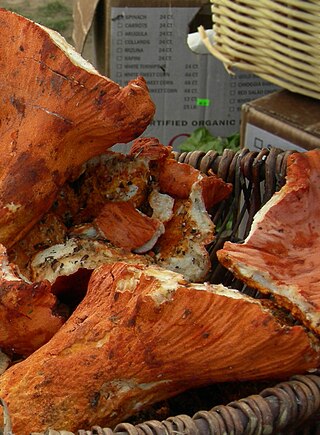
Hypomyces is a genus of parasitic ascomycete fungi found in Europe, North America, Australia, and parts of China. The genus contains 53 species. Better known species include the lobster mushroom and the bolete eater.

Tapinella atrotomentosa, commonly known as the velvet roll-rim or velvet-footed pax, is a species of fungus in the family Tapinellaceae. Although it has gills, it is a member of the pored mushroom order Boletales. August Batsch described the species in 1783. It has been recorded from Asia, Central America, Europe and North America. Tough and inedible, it grows on tree stumps of conifers. The mushroom contains several compounds that act as deterrents of feeding by insects.
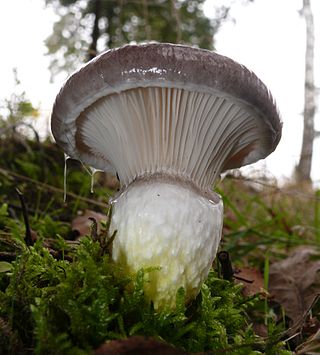
Gomphidius glutinosus, commonly known as the slimy spike-cap, hideous gomphidius, or glutinous gomphidius is a gilled mushroom found in Europe & North America. Although it has gills, it is a member of the order Boletales, along with the boletes. The fruiting bodies sprout in pine, fir and spruce woodland in Europe in autumn. Initially, are completely covered with a slimy veil, breaking through to reveal a greyish or brownish-capped mushroom with decurrent greyish gills which sometimes resembles a child's top. Opinions differ on the suitability of this mushroom for the table, some guides hold it in high regard, while others view it with caution.

Geopyxis carbonaria is a species of fungus in the genus Geopyxis, family Pyronemataceae. First described to science in 1805, and given its current name in 1889, the species is commonly known as the charcoal loving elf-cup, dwarf acorn cup, stalked bonfire cup, or pixie cup. The small, goblet-shaped fruitbodies of the fungus are reddish-brown with a whitish fringe and measure up to 2 cm across. They have a short, tapered stalk. Fruitbodies are commonly found on soil where brush has recently been burned, sometimes in great numbers. The fungus is distributed throughout many temperate regions of the Northern Hemisphere. It is found in Europe, Turkey, and North America. Although it is primarily a saprotrophic species, feeding on the decomposing organic matter remaining after a fire, it also forms biotrophic associations with the roots of Norway spruce.

Suillus spraguei is a species of fungus in the family Suillaceae. It is known by a variety of common names, including the painted slipperycap, the painted suillus or the red and yellow suillus. Suillus spraguei has had a complex taxonomical history, and is also frequently referred to as Suillus pictus in the literature. The readily identifiable fruit bodies have caps that are dark red when fresh, dry to the touch, and covered with mats of hairs and scales that are separated by yellow cracks. On the underside of the cap are small, yellow, angular pores that become brownish as the mushroom ages. The stalk bears a grayish cottony ring, and is typically covered with soft hairs or scales.
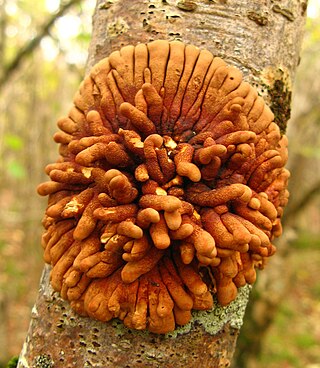
Hypocreopsis is a genus of ascomycete fungi that form stromata on the stems of trees and shrubs. The stromata are orange-brown and consist of radiating, perithecial lobes.

Leotia lubrica, commonly referred to as a jelly baby, is a species of fungus in the family Leotiaceae. The species produces small fruit bodies up to 6 centimetres (2.4 in) in height, featuring a "head" and a stalk. Ochre with tints of olive-green, the heads are irregularly shaped, while the stalk, of a similar colour, attaches them to the ground. The appearance can be somewhat variable and is similar to a number of other species, including Cudonia confusa, C. circinans, L. atrovirens and L. viscosa. L. lubrica was first validly described by Giovanni Antonio Scopoli, but it was later transferred to Leotia by Christiaan Hendrik Persoon. Its relationship with other members of the genus, of which it is the type species, is complicated.

Xylobolus frustulatus, commonly known as the ceramic fungus or ceramic parchment, is an inedible species of crust fungus in the Stereaceae family. The fruit body forms small, hard, flat crust-like aggregations that resemble broken pieces of ceramic tile. These pieces are initially whitish before turning yellow-brown to gray-brown in age. The spore-bearing cells cover the upper surfaces of the fruit body. A saprobic species, it grows on well-decayed oak wood in Asia, northern Europe, and North America.
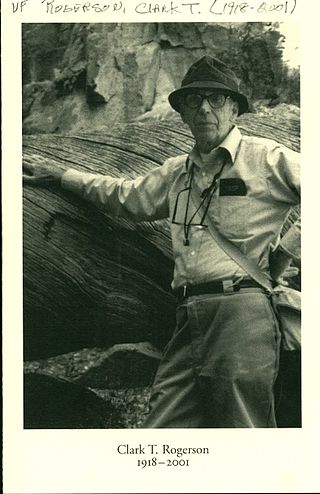
Clark Thomas Rogerson,, was an American mycologist. He was known for his work in the Hypocreales (Ascomycota), particularly Hypomyces, a genus of fungi that parasitize other fungi. After receiving his doctorate from Cornell University in 1950, he went on to join the faculty of Kansas State University. In 1958, he became a curator at The New York Botanical Garden, and served as editor for various academic journals published by the Garden. Rogerson was involved with the Mycological Society of America, serving in various positions, including president in 1969. He was managing editor (1958–89) and editor-in-chief (1960–65) of the scientific journal Mycologia.

Glutinoglossum glutinosum, commonly known as the viscid black earth tongue or the glutinous earthtongue, is a species of fungus in the family Geoglossaceae. Widely distributed in the Northern Hemisphere, it has been found in northern Africa, Asia, Europe, and North America. Although previously thought to exist in Australasia, collections made from these locations have since been referred to new species. G. glutinosum is a saprophytic species that grows on soil in moss or in grassy areas. The smooth, nearly black, club-shaped fruitbodies grow to heights ranging from 1.5 to 5 cm. The head is up to 0.7 cm (0.3 in) long, and the stipes are sticky. Several other black earth tongue species are quite similar in external appearance, and many can be reliably distinguished only by examining differences in microscopic characteristics, such as spores, asci, and paraphyses. First described in 1796 as a species of Geoglossum, the fungus has gone through several changes of genera in its taxonomic history. It was placed in its current genus, Glutinoglossum, in 2013.

Glutinoglossum is a genus of six species of earth-tongue fungi in the family Geoglossaceae. The widespread type species, G. glutinosum, is commonly known as the "glutinous earth tongue". G. heptaseptatum is known only from the Czech Republic. Four additional species were described in 2015.

Hypomyces cervinigenus is a parasitic ascomycete fungus that grows on elfin saddle (Helvella) mushrooms in Europe and North America.

Hypomyces papulasporae is a parasitic ascomycete in the order Hypocreales. It was described as new to science in 1985. The type collection, made in New Zealand, was found growing on the ascomata of Trichoglossum hirsutum. H. papulasporae has Sibirina- and Papulaspora-like synanamorphs.
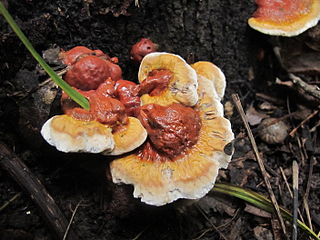
Ganoderma sessile is a species of polypore fungus in the Ganodermataceae family. This wood decay fungus is found commonly in Eastern North America, and is associated with declining or dead hardwoods. There is taxonomic uncertainty with this fungus since its circumscription in 1902.
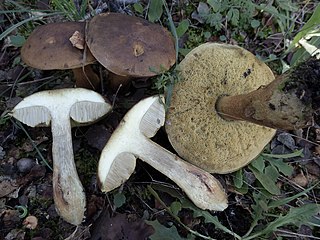
Leccinellum lepidum is a species of bolete in the family Boletaceae. Originally described as Boletus lepidus in 1965, the fungus has gone through controversial taxonomic treatments over the years and was subsequently transferred to genus Krombholziella in 1985, to genus Leccinum in 1990, and to genus Leccinellum in 2003. It is the sister-species of Leccinellum corsicum, with which it had been erroneously synonymised by some authors in the past.
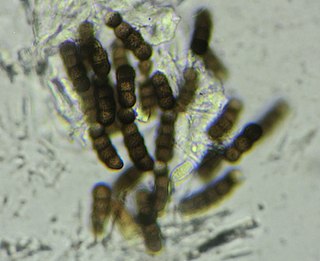
Torula herbarum is a darkly-pigmented filamentous fungus in the phylum Ascomycota. It is often included in the unrelated but morphologically similar group of fungi known as sooty molds. It was first described by Persoon in the genus Monilinia based on similarity to the agent of brown rot of stone fruit but later transferred to the genus Torula by Link. Conidia of T. herbarum are dark brown or olivaceous colour and have a distinctive shape and number of cells. T. herbarum produces secondary metabolites with cytotoxic activity towards bacteria and human cancer cells.
Capronia mansonii is a mesophilic black yeast that is a part of the Herpotrichiellaceae. The species is uncommon in nature but is saprotrophic in nature and been discovered on decaying plant matter, particularly wood. This fungus is naturally found in the Netherlands and has successfully been cultured in lab. It is a teleomorph of the ascomycota division and possesses brown spores.
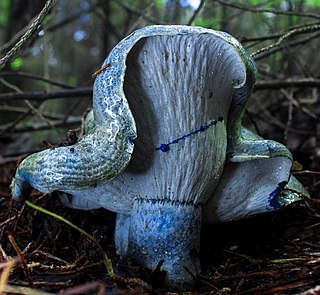
Hypomyces lateritius is a parasitic ascomycete fungus that grows on certain species of Lactarius mushrooms, improving their flavor and densifying the flesh. Hosts include L. camphoratus, L. chelidonium, L. controversus,L. deliciosus, Lactarius indigo, L. rufus, L. salmonicolor, L. sanguifluus, L. semisanguifluus, L. tabidus, L. trivialis, and L. vinosus.


















